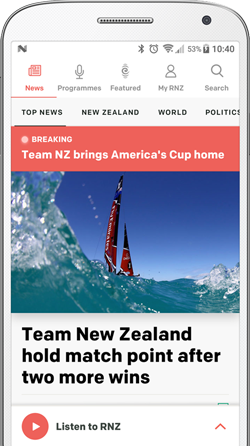By Gavin McGrath, ABC News

The frightening face of the deep-sea lizardfish. Photo: Supplied: Ben Healley, Museums Victoria
Four thousand metres below the Southern Ocean surface lies a mysterious and alien world.
Deep within the Bass Canyon - an 80km-long yawning gash in the seafloor - is a place of near complete darkness and crushing pressures.
The temperature in the canyon is barely above freezing, and the conditions are seemingly incompatible for life.
But the Bass Canyon is far from lifeless. There is a staggering diversity of strange creatures, the likes of which rarely see the light of day.

Georgia Nester says few have seen this part of the planet. Photo: Supplied: Maren Preuss, CSIRO
The CSIRO's Research Vessel Investigator explored this submarine crevice with a combination of multi-beam sonar and visual camera photography during its autumn cruise off the Tasmanian coast.
RV Investigator's chief science officer Dr Georgia Nester said it was a rare opportunity to peer into a part of the planet few have seen.
"We were lucky enough to do a deployment at 3,000m and have a look at what's down there," Nester said.
"We did a drop-tow camera, we did a CTD [conductivity, temperature, and depth measurement] and hopefully we'll be able to analyse that data and figure out all of the weird and wacky creatures living down there."

Bass Canyon can reach depths of 4500m. Photo: CSIRO
Freaky creatures
While many of these creatures would not look out of place in some deep-sea horror film, Nester said few were as fearsome as they appeared.
"I think the deep-sea creatures, they're always a little bit freakier than their shallow water counterparts," she said.
"We did find a really cute octopus, but we also see sharks which have freaky little pointy noses and teeth all over their face.
"A lot of the time, especially in deeper water, we have these fish that'll be a little bit gelatinous like those blobfish many people think of. So they're a bit squishy.
Nester said the deep ocean was often associated with scary predators, but the reality was quite different.
"The deep sea has a bit of a bad reputation in the sense that everyone thinks it's a little bit frightening, but many are scavengers," Nester said.
"They're not exactly big apex predators, so not as scary as you may think."

A tripod fish on the Bass Canyon floor, as seen through the CSIRO's camera. Photo: CSIRO
Exploring the depths
The first steps in exploring the canyon were several passes over it using Investigator's permanent sonar system.
"It allows us to get good, high-resolution mapping of the lay of the land underneath the vessel on the sea floor," marine biologist and RV Investigator CAPSTAN voyage manager Dr Ben Arthur explained.
"It's the equivalent of a very powerful, very fancy fish finder."
Arthur said sonar mapping was just the first stage, and allowed the team to gain insights into the canyon before deploying additional equipment.
"It's sending out sound waves into the water and hitting something, in this case the sea floor; it bounces back so we can listen for it," Arthur said.
"Through some complicated data processing, you can determine the depth and how steep the slope is, because that will determine the speed we will be towing equipment through that canyon system.
"We then deploy the deep-tow camera, which uses a high-resolution camera in a titanium housing we've engineered here to cope with the pressure.
He said the camera also had a powered frame for lights and for enabling images to be sent back in real time.

CSIRO's Research Vessel (RV) Investigator. Photo: Supplied: Wild Pacific Media
Discovering and cataloguing the inhabitants of the canyon was only one element of the ship's voyage to the west of Tasmania.
It primary function was as CAPSTAN (Collaborative Australian Postgraduate Sea Training Alliance Network) training cruise. CAPSTAN is a maritime education and training initiative of CSIRO.
The voyage enabled 21 postgraduate students from 16 universities to be introduced to life aboard the research vessel and to get the opportunity to operate the equipment.
Nester said the Bass Canyon tour was one perk of the tour, which included a circumnavigation of Tasmania.
"I guess it's knowing that the parts of the sea floor that you're watching, no one else has seen before," Nester said.
"That's really special, going to these depths. It's really a bucket-list thing for me."
- ABC News






